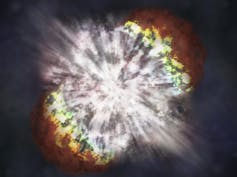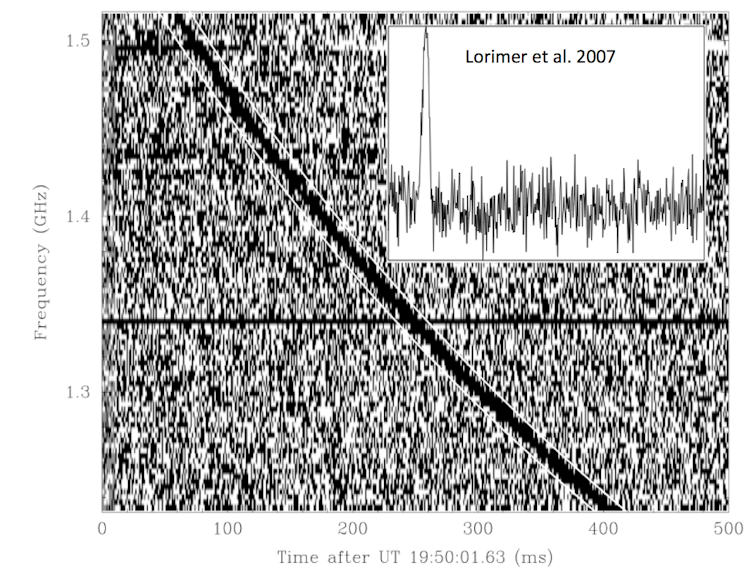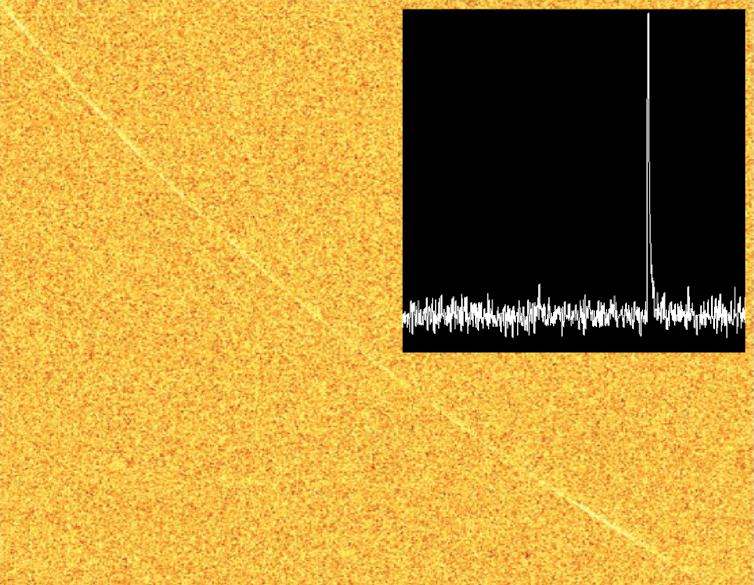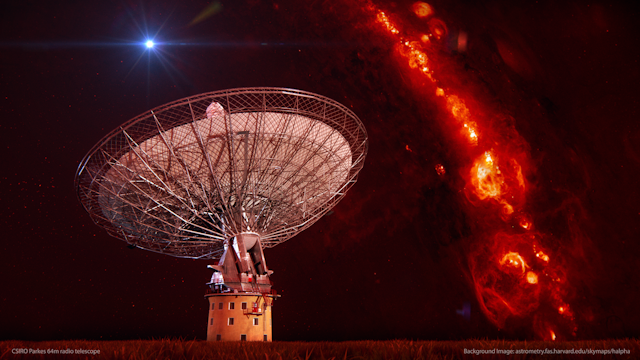How many electrons are there in the universe? That may seem nigh on impossible to calculate – let alone comprehend – but the discovery of a new population of astrophysical events called Fast Radio Bursts (FRBs), published in Science today by my colleagues and I, could help provide a solution to this fundamental cosmological question.
The FRBs, discovered with the CSIRO’s Parkes radio telescope in New South Wales, confirm the validity of the amazing “Lorimer burst”, a mysterious event that occurred in 2001 and has until now been quite controversial.
The techniques for finding FRBs closely mirror those used to discover pulsars, sources of radio emission emitted in lighthouse-like beams first discovered in 1967 by the Northern-Irish astrophysicist Jocelyn Bell.
Though we don’t yet know for sure, it’s worth pointing out that FRBs are probably caused by some catastrophic event in the distant universe. They almost certainly occur in galaxies and probably involve relativistic objects such as black holes or neutron stars.
Some candidates are millisecond-duration explosions on the surface of ultra-magnetic neutron stars known as magnetars, coalescing neutron stars or supernova explosions.
FRB cousins: the gamma-ray bursts
One of the greatest discoveries of the modern astrophysical era were the gamma ray bursts, or GRBs. GRBs are associated with exploding stars and have allowed astronomers to see back until the universe was only a small fraction of its current age. They are short (few second) bursts of gamma-rays that occur infrequently and appear to be randomly distributed on the sky.
The first GRBs were found by satellites designed to detect nuclear tests during the Cold War, and to the shock of the engineers involved, seemed to indicate that nuclear tests were being conducted in space!

It took more than 20 years for astronomers to ascertain what the GRBs were, but the mystery was eventually (at least partially) solved when a nearby GRB was associated with a supernova explosion. This led to their correct interpretation and their extreme luminosity has enabled astronomers to learn not only about what the GRBs are, but also about the evolution of the universe.
Getting to know you
The FRBs are not (yet) associated with GRBs, but have some similarities.
They are short duration (a few milliseconds) bursts of radio emission that arrive first at high frequencies and then progressively sweep to lower frequencies before disappearing completely and not recurring. The sweep from high radio frequencies to low is called “pulse dispersion”, and has a characteristic form.
On their approximately 10-billion-year intergalactic voyage, every time the radio waves pass an electron they are delayed in a frequency-dependent manner that ultimately amounts to about a one second difference across our observing frequency range. This delay, shown in the figures below, allows us to “count” the number of electrons between us and the burst.
The beautiful sweep and pulse shape of the radiation obeys the theoretically-predicted relation for a burst of radio waves that has propagated across the universe.
Since we think most of the atoms in the universe have lost their electrons, counting them gives us a fundamental insight into the amount of normal or “baryonic” matter in it. Like the GRBs before them, at present we have no solitary idea of what the FRBs are, and like the GRBs they appear to come from great distances, such as halfway across the observable universe.
A population of FRBs at different stages of the universe’s age would be an invaluable resource, allowing us to map the evolution of the mass distribution. They’re potentially a cosmological gold mine!
But the history of the FRBs has not been without controversy. The first example of an FRB was the famous “Lorimer burst”, mentioned at the outset of this article and reported in Science in 2007 by astrophysicist Dunc Lorimer and colleagues.

Unlike most controversial results, the Lorimer burst’s problem was not that it was too weak, but rather that it was too bright! Fainter, more distant analogues should be seen, and none were, despite large international efforts.
Interest in the subject waned - until last year.
The High Time Resolution Universe Surveys
Since most pulsars live in our galaxy, pulsar astronomers invariably hunt for them in the plane of the Milky Way; once this area is exhausted they reluctantly move to high galactic latitudes.
The surveys our international team have been conducting at the Parkes 64-metre telescope were no exception.
In mid 2012, University of Manchester PhD student Dan Thornton started looking intensively through the results of the relatively boring “off plane” regions for pulsars, rotating radio transients (short radio pulses), and just maybe, Lorimer bursts.
Dan was somewhat daunted by the presence of radio interference, and his supervisor Ben Stappers suggested he just “set a high threshold” and see if there was anything interesting in his data.
Shortly afterwards he discovered the first burst - FRB 110220 shown below - an amazingly bright pulse and with a dispersion delay some three times that of the Lorimer burst!

Director of Germany’s Max Planck Institute for Radio Astronomy Michael Kramer demonstrated with our new digital equipment the pulse’s dispersion (time delay) sweep could be shown to be perfectly consistent with the theoretically-expected relation, but we still had the problem that we should be seeing other, still weaker, bursts.
Dan soon uncovered two fainter bursts, and then a third, and our confidence in them grew.
The four bursts published in today’s Science paper are certainly consistent with them being part of the same population as the Lorimer burst. The telescope’s observed field of view and event rate suggest that every day, a few thousand similar radio bursts strike Earth; however, we have the instrumentation to detect only one every week or two of observing time, and only when far from the galactic plane.
If we can get more accurate positions, the FRBs will be arguably one of the most important cosmological probes we possess. The combination of a host galaxy redshift and the dispersion time provides the mass of normal matter in the universe in a completely new way.
Origins
From here, astronomers will pursue the joint aims of determining the origin of the bursts and using them to gain new insights into the universe.
Our team now have a real-time burst detector operating at the Parkes telescope and are hoping to refurbish the University of Sydney’s old Molonglo radio telescope near Canberra to be a dedicated FRB finder. Looking further afield, the Square Kilometre Array and its pathfinders should detect these bursts at rapid rates and allow us to determine their host galaxies.
Last night we found a new event, and the hunt for the origin and physical understanding of these new intergalactic messengers is sure to continue at a furious pace.
Acknowledgements:
I am indebted to the entire HITRUN team [D. Thornton, B.Stappers, B. Barsdell, S. Bates, N. D. R. Bhat, M. Burgay, S. Burke-Spolaor, D. Champion, P. Coster, N. D'Amico, A. Jameson, S. Johnston, M. Keith, M. Kramer, L. Levin, S. Milia, C. Ng, A. Possenti, W. van Straten] and their host institutions, the Universities of Manchester, Swinburne, Curtin, and WVU, INAF, MPI for Radio Astronomy, JPL/Caltech and CSIRO’s CASS division. Special thanks to Dan Thornton for his Jocelyn Bell-like diligence and patience and also to Dunc Lorimer for involving me in the original Lorimer burst discovery and follow-ups. This research is supported in Australia by the ARC and CSIRO’s Astronomy and Space Science division. Matthew Bailes is the Dynamic Universe theme leader of the ARC Centre of Excellence for All-sky Astrophysics “CAASTRO”.

